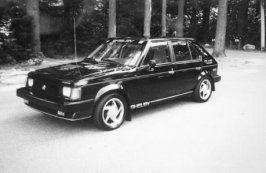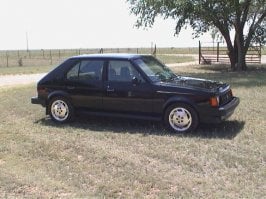- 263
SHELBY DODGE OMNI/PLYMOUTH HORIZON 
The second car Shelby focused on was the Omni. First released in 84, it was called the Omni GLH. The story of its name is loosely as follows: the car was seen as competing with Volkswagen's souped-up Rabbit, the GTI. A Chrysler executive therefore came up with an appropriate name for the hotrod Omni: the Coyote. After all, coyotes eat rabbits, right? Well, this name was rejected. The designers were then asking themselves what they should call it. Shelby offered that it should be called the GLH "because it goes like hell." When the corporate leaders were shocked to hear his proposed name, he answered "who's gonna know?" The moniker stuck all the way to production.
The pedestrian Omni and Charger are based on the same platform and are almost completely identical mechanically; thus the GLH was nearly identical to the Shelby Charger as far as all hardware was concerned. All of the Shelby Charger's suspension and brake upgrades were carried over, and the GLH also wore 195/50 tires on the same 4-lug aluminum "swiss cheese" wheels (seen below). All 84 GLHs received the identical high output carbureted 2.2 making the same 110 hp along with the same, 3.87:1 final-drive 5-speed transmission. Due to its slightly reduced weight and its reduced aerodynamics, the GLH hit 60 in only 8.7, turned a 16.7 ET at 81 mph, but topped out at 106 mph.
A significant difference was seen elsewhere... literally. Unlike the Shelby Charger, the GLH used a standard Omni interior and had a monochrome paint job. (Exterior colors were initially limited to Black, Gold Dust, Graphic Red, and Radiant Silver. However, it seems that late in the model year another color was introduced: Santa Fe Blue.) Because the GLH was not as attention-grabbing, this car became a sleeper on the street; you had to look closely to notice its integrated driving lights, the discreet GLH decals, or the blacked-out trim (note the picture below). GLH production for 1984 was 3,285 cars; I do not have information to break this total down color by color.
Big news for the 85 model year was the same turbomotor seen in the Shelby Charger. Note that it was optional in the GLH; the high-output carburated engine (along with its lower-geared transmission) remained standard equipment. The turbocharged engine produced the same 146 hp as in the Shelby Charger, and was backed by the same taller-geared (3.56:1) 5-speed transmission. The new 5-lug aluminum "pizza" wheels (Seen on the car below) were installed, also like on the 85 Shelby Charger, but an important distinction is that the GLH still wore 195/50s, even with the turbo engine. When so equipped, the turbocharged engine pushed the GLH from 0-60 in 7.5 seconds and through the quarter in 15.8 seconds at 87 mph; top speed was up to 119 mph.
Also new that year were black side skirts and a black airdam; they were part of the GLH Performance package and were thus featured on all GLH cars, carbed or turbo. The driving lights were now integrated into the airdam. Santa Fe Blue was now a color choice for the entire model year (only GLH Omnis could get this color). Still, the GLH remained a stealth machine on the street. GLH production in 85 was 6,513 cars: 3,004 carburated and 3,509 GLH Turbos. Of all 6,513 cars, 1,269 were painted Santa Fe Blue; I have no other color-by-color info.
1986 would be the last year for the GLH. As such, the car was completely carryover; the third brakelight being grafted onto the hatch (as required by the then-new federal regulation) was the only change. The 2-bbl was still standard, and the turbo was still optional. Production for the 1986 year was 3,129 cars: 882 carburated and 2,247 GLH Turbos. Of these 3,129 cars, 824 were Santa Fe Blue.

The second car Shelby focused on was the Omni. First released in 84, it was called the Omni GLH. The story of its name is loosely as follows: the car was seen as competing with Volkswagen's souped-up Rabbit, the GTI. A Chrysler executive therefore came up with an appropriate name for the hotrod Omni: the Coyote. After all, coyotes eat rabbits, right? Well, this name was rejected. The designers were then asking themselves what they should call it. Shelby offered that it should be called the GLH "because it goes like hell." When the corporate leaders were shocked to hear his proposed name, he answered "who's gonna know?" The moniker stuck all the way to production.
The pedestrian Omni and Charger are based on the same platform and are almost completely identical mechanically; thus the GLH was nearly identical to the Shelby Charger as far as all hardware was concerned. All of the Shelby Charger's suspension and brake upgrades were carried over, and the GLH also wore 195/50 tires on the same 4-lug aluminum "swiss cheese" wheels (seen below). All 84 GLHs received the identical high output carbureted 2.2 making the same 110 hp along with the same, 3.87:1 final-drive 5-speed transmission. Due to its slightly reduced weight and its reduced aerodynamics, the GLH hit 60 in only 8.7, turned a 16.7 ET at 81 mph, but topped out at 106 mph.
A significant difference was seen elsewhere... literally. Unlike the Shelby Charger, the GLH used a standard Omni interior and had a monochrome paint job. (Exterior colors were initially limited to Black, Gold Dust, Graphic Red, and Radiant Silver. However, it seems that late in the model year another color was introduced: Santa Fe Blue.) Because the GLH was not as attention-grabbing, this car became a sleeper on the street; you had to look closely to notice its integrated driving lights, the discreet GLH decals, or the blacked-out trim (note the picture below). GLH production for 1984 was 3,285 cars; I do not have information to break this total down color by color.
Big news for the 85 model year was the same turbomotor seen in the Shelby Charger. Note that it was optional in the GLH; the high-output carburated engine (along with its lower-geared transmission) remained standard equipment. The turbocharged engine produced the same 146 hp as in the Shelby Charger, and was backed by the same taller-geared (3.56:1) 5-speed transmission. The new 5-lug aluminum "pizza" wheels (Seen on the car below) were installed, also like on the 85 Shelby Charger, but an important distinction is that the GLH still wore 195/50s, even with the turbo engine. When so equipped, the turbocharged engine pushed the GLH from 0-60 in 7.5 seconds and through the quarter in 15.8 seconds at 87 mph; top speed was up to 119 mph.
Also new that year were black side skirts and a black airdam; they were part of the GLH Performance package and were thus featured on all GLH cars, carbed or turbo. The driving lights were now integrated into the airdam. Santa Fe Blue was now a color choice for the entire model year (only GLH Omnis could get this color). Still, the GLH remained a stealth machine on the street. GLH production in 85 was 6,513 cars: 3,004 carburated and 3,509 GLH Turbos. Of all 6,513 cars, 1,269 were painted Santa Fe Blue; I have no other color-by-color info.
1986 would be the last year for the GLH. As such, the car was completely carryover; the third brakelight being grafted onto the hatch (as required by the then-new federal regulation) was the only change. The 2-bbl was still standard, and the turbo was still optional. Production for the 1986 year was 3,129 cars: 882 carburated and 2,247 GLH Turbos. Of these 3,129 cars, 824 were Santa Fe Blue.




 )
)



